
Today’s bobbers, as a style, could be described as less than sensible. They prize form over function, emotion and feel over pure logic. If Freud’s id, ego and super-ego structural model of the human psyche were applied to motorcycles, bobbers would be the id. Nothing wrong with that; Freud’s id represents our basic human instincts and biological needs. In motorcycling terms, it’s the essence of riding—the feelings we get when we’re on two wheels.
While the bobbers of old were generally garage-built jobs, manufacturers have recently discovered there is a market for ready-to-ride factory bobbers, so we procured a few that represent various approaches to the bobber life. With little in the way of whiz-bang electronics or high-tech features, comparing these three bikes is all about look and feel—satisfying our motorcycle id. Sensibility be damned, let’s go for a ride!
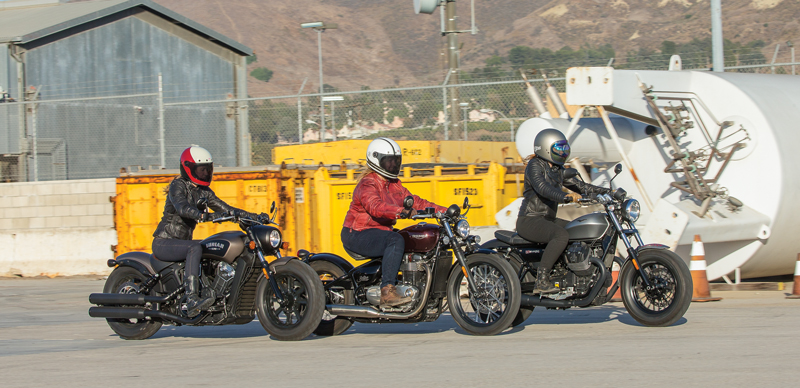
She’s Got The Look
When I asked two of my riding buddies if they were interested in helping with a bobber photo shoot, after saying “yes” (because who would say “no?”), they asked, “What exactly makes a bobber a bobber?” The short answer is: they have a certain look. But unlike, say, café racers, which are fairly homogenous, bobbers are open to interpretation. When the style originated post-WWII, bobbers were regular motorcycles that had been stripped of anything not related to going fast, their fenders often “bobbed” to save weight. Later versions sprouted ape hanger handlebars, tractor-style solo saddles, blacked-out components and fat front tires.
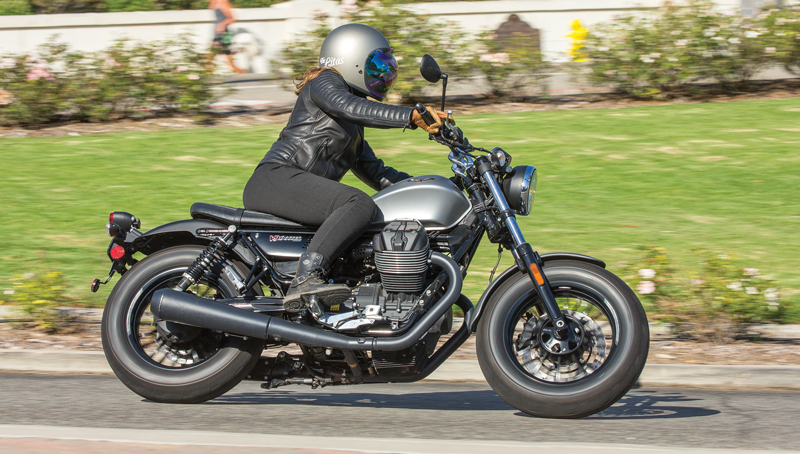
Chloe’s gear:
Helmet: Biltwell Gringo
Jacket: Atwyld Alltime Moto
Pants: GoGo Gear Leggings
Boots: Harley-Davidson
Because of this openness, our three specimens don’t look exactly alike. The Moto Guzzi was the first of the three to be introduced as a factory bobber, in 2016 (read the First Ride Review here). It’s the least “bobber-like” and more like a stripped-down standard, although it does check the fat front tire, blacked-out component and bobbed fender boxes. It turns heads despite its understated nature, thanks to its longitudinal 853cc 90-degree V-twin—which some riders might find comes into contact with their knees. Its 30.7-inch seat is more than 5 inches taller than the Indian’s, and it rides like a typical standard: sitting upright on the long, flat seat, feet under you, hands gripping the wide handlebar.
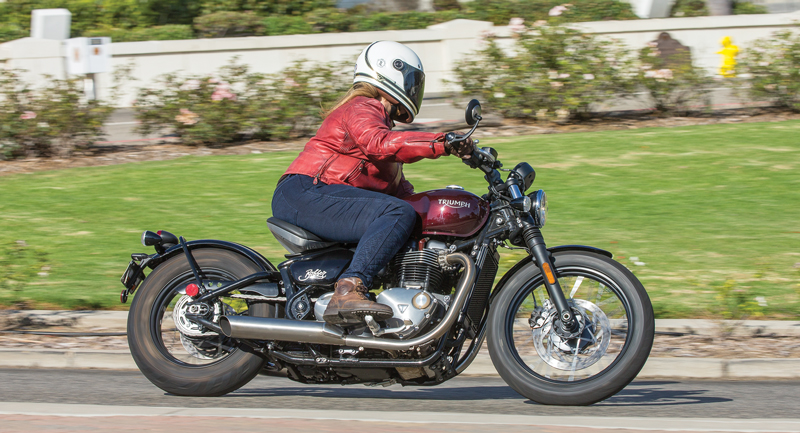
Marylou’s Gear:
Helmet: Bell Bullitt
Jacket: Roland Sands Design Trinity
Pants: Atwyld Commuter Moto Jeans
Boots: Rev’It
At the other end of the spectrum is the Triumph (read our First Ride Review here). Ask a time-traveling 1950s motorcyclist what a bobber looks like, and he or she would likely point at the modern Bonneville Bobber. Mid-mount controls put the rider’s knees at a comfortable angle, the 27.2-inch dished solo seat is surprisingly comfortable and the small 2.4-gallon gas tank means the reach to the flat handlebar isn’t too much of a stretch. At its heart is the smooth liquid-cooled, 1,200cc parallel twin that powers the Bonneville T120, our 2016 Motorcycle of the Year, but for Bobber duty it gets a special tune for a more linear torque curve.
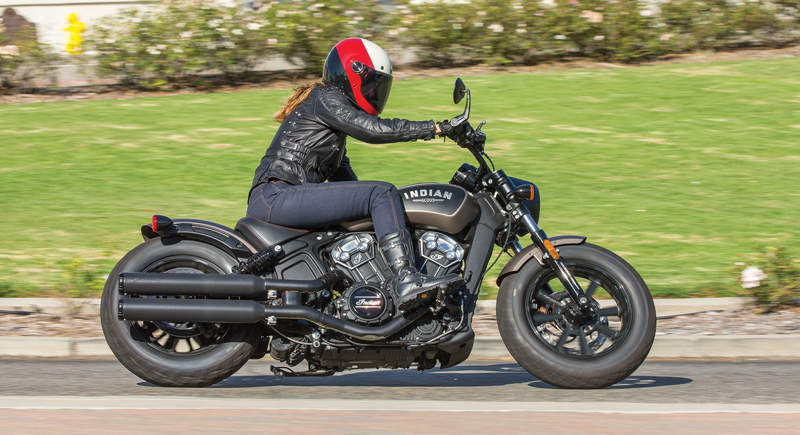
Jenny’s Gear:
Helmet: Bell Bullitt
Jacket: Black Brand Brazilian Waxed
Pants: Bolid’ster Jeny’ster
Boots: Stylmartin Continental
Then there’s the Indian (read the First Ride Review here), which could be considered the prototypical modern American bobber: slammed appearance, chunky semi-knobby tires, matte paint, blacked-out components, a side-mounted license plate and an aggressive riding position. The Scout Bobber is powered by the same spirited 69ci (1,133cc) liquid-cooled, DOHC, 8-valve V-twin used in the standard Scout. Its low 25.6-inch solo saddle is actually a third of an inch higher than the Scout’s, thanks to additional padding under the attractive two-tone leather cover, and the forward controls were moved 1 1/2 inches farther back. Combined with the long reach to the handlebar, this puts the rider into a clamshell posture that works fine for my 5-foot, 9-inch frame but might not be as comfortable if you’re outside the “average.” For taller riders, Indian offers Extended Reach footpeg relocation kits.
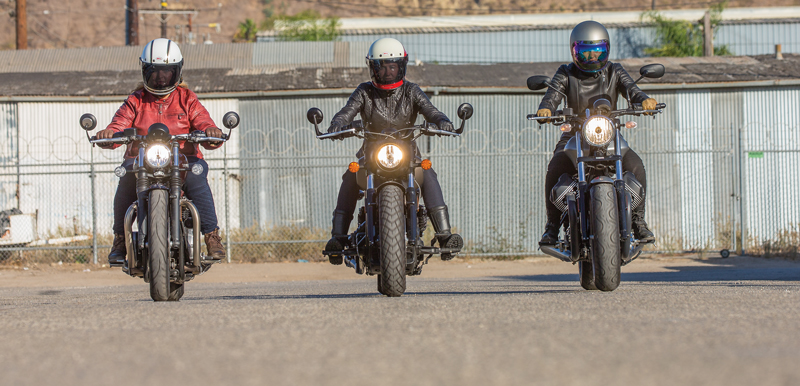
Dr. Feelgood
Given the nature and purpose of these machines, we spent most of our time roaming the urban jungle and cruising beachfront boulevards, although being the type of riders we are we also flogged each one on some favorite local canyon roads.
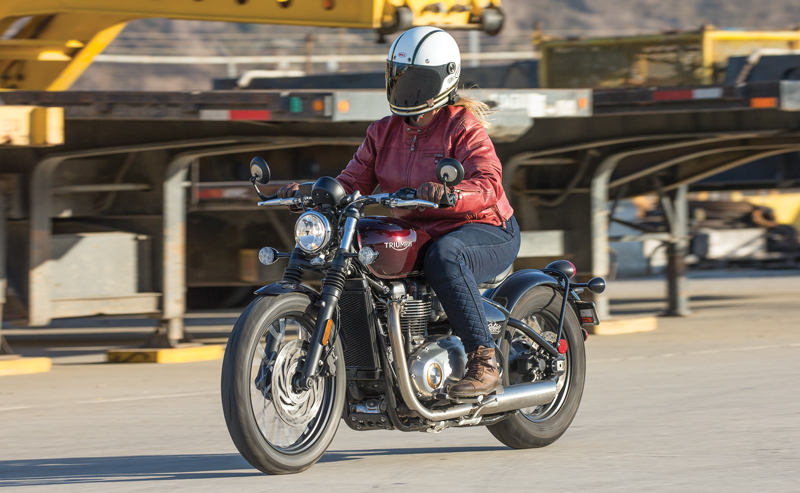
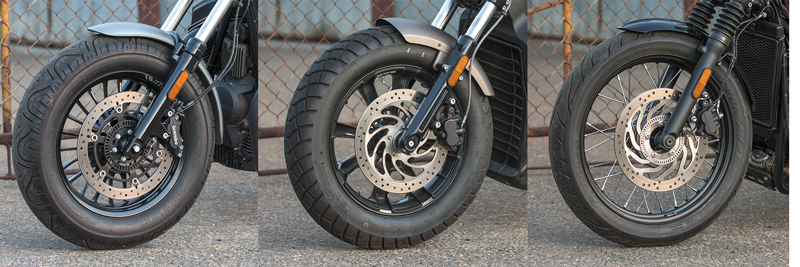
True to form, the Triumph is the distinguished gentleman of the group. It’s the only one of the three to offer ABS, switchable traction control and two ride modes (Rain and Road) as standard, and with an adjustable seat, brake and clutch lever, it’s accommodating for riders of many sizes. Throttle response is smooth and crisp, with the parallel twin doling out 74.4 horsepower at 6,000 rpm and 73.4 lb-ft of torque at 4,000 on the Jett Tuning dyno. Unlike the muted whir-and-purr of the Guzzi and the bark of the Indian, the Triumph’s sound is musical, striking an ideal balance between volume and tone. At 534 pounds wet, it’s 8 pounds lighter than the Indian, but thanks to its tall 19-inch front wheel it steers slower, especially at low speeds. Short (3.5-inch front, 3-inch rear), stiff suspension is jarring at any speed and wreaks havoc with handling on bumpy pavement, and weak brakes do little to add confidence. On a smooth, moderately curvy road, however, the Triumph is sublime. We just wish the fun lasted for more than 114 miles at a time.
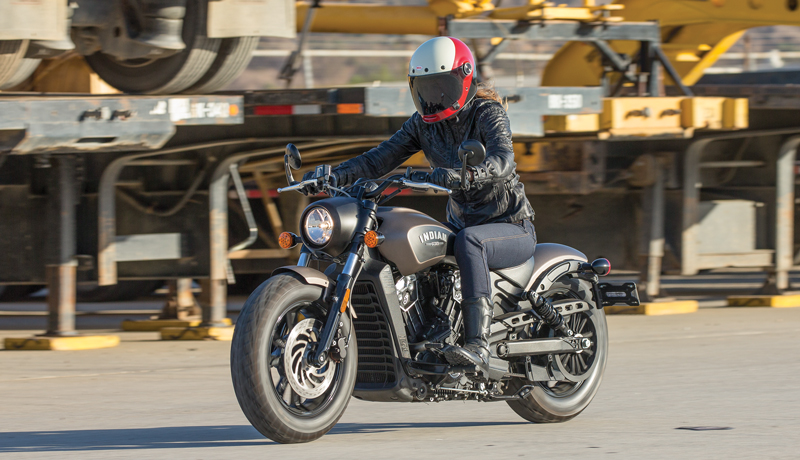
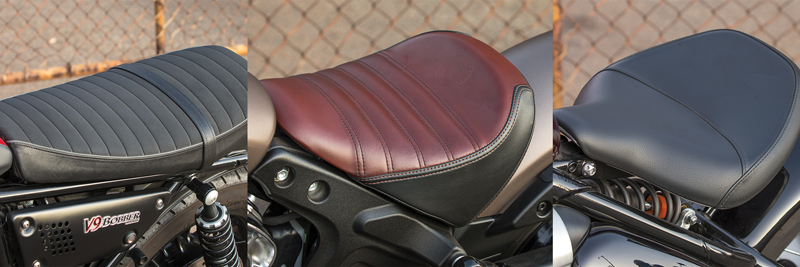
With your tailbone pressed into the saddle’s rear scoop and leaning forward to grip the handlebar, climbing aboard the Indian is a completely different experience. The Scout Bobber’s fit and finish rivals the Triumph, but it feels more raw and explosive, with the rev-happy liquid-cooled V-twin churning out 81.6 horsepower at a howling 8,000 rpm and 61.7 lb-ft of torque at 5,600. Maybe it’s the aggressive posture, but I succumbed to throttle twisting temptation more on the Indian than on the other two; this thing encourages your inner hooligan. There’s no traction control and ABS is available but was not on our test bike, leaving ultimate control up to good old-fashioned American free will. Despite its chunky appearance, the Scout Bobber is light and nimble on its feet, proving to be easy to handle at parking lot speeds and turning in quicker in the canyons than the Triumph. The compliance of its cartridge-style fork with 4.7 inches of travel helps to make up for the meager 2-inch-travel dual rear shocks, and twin 298mm brake discs offer much better performance and feedback than the Triumph, especially the rear. It feels more sophisticated than the Guzzi but less so than the Triumph, and has plenty of V-twin vibration, a sometimes notchy gearbox and a light throttle that feels a bit uneven at times.
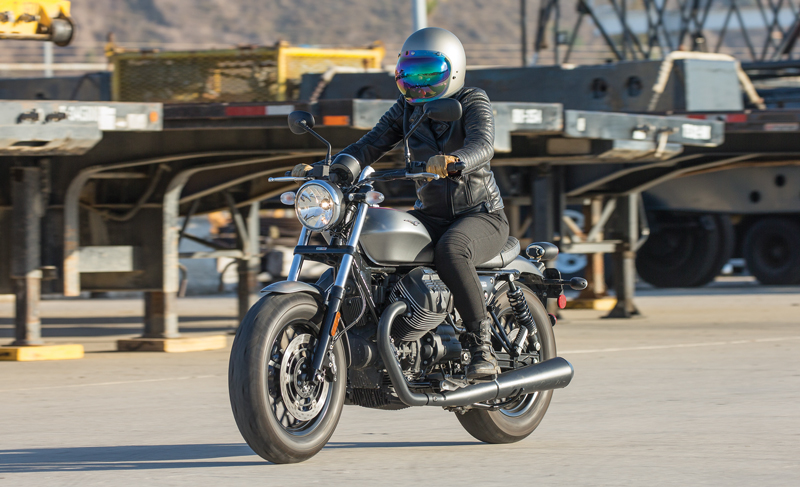
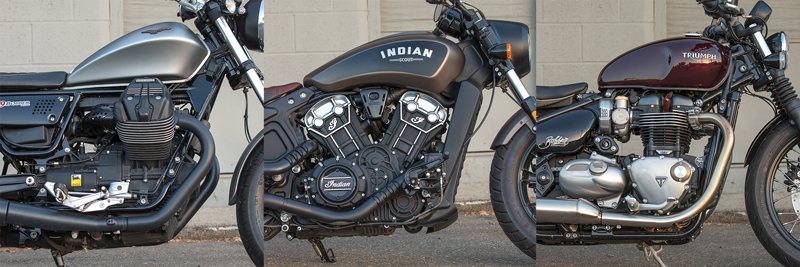
The Moto Guzzi, meanwhile, ends up being the most sensible of the group—not much of a surprise given it’s the least like a traditional bobber. The smaller air-/oil-cooled engine puts 51.3 horsepower at 6,000 rpm and 47.3 lb-ft at 3,500 to the rear wheel via shaft drive, well below the output of the other two. It doesn’t invite as much wrist twisting either, which helps stretch the fuel range from the 4-gallon tank to 183 miles. Despite having the lowest price of the trio, the Guzzi comes standard with ABS and switchable traction control, and Brembo brakes serve up decent power and feedback. It has its own Italian character; the needle on the analog speedometer tends to vibrate wildly at certain speeds, you hear—and feel—every gear shift and clutch pull, and the black anodized finish on the mufflers is a bit flaky. A spindly 40mm fork and dual rear shocks offer the best travel of the trio (5.1 inches at the front, 3.8 at the rear), but suffer from a lack of rebound damping, exaggerating low-speed bumps like a pogo stick. All of this aside, if you don’t need the excitement of the Indian or the sophistication of the Triumph, the Guzzi might be the easiest to live with. You could strap a tail bag to the seat, attach a magnetic tank bag to the steel tank and take it on a road trip, or cruise down to the pier with a friend on the back for fish tacos.
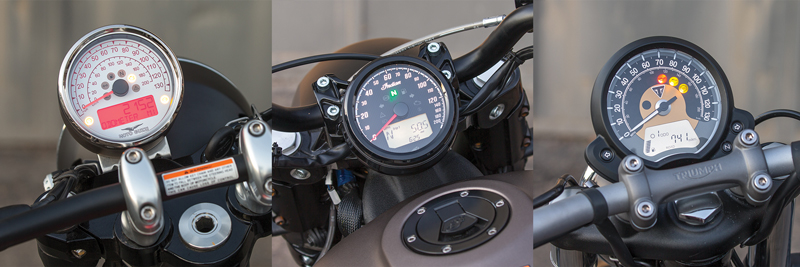
Now for the hard part, the final act—picking a “winner.” If I were in the market for a truly unique neo-retro standard, the Guzzi would be near the top of my list…but as a bobber it’s not what I’m looking for. Which leaves the Triumph and the Indian. And I can’t decide.
I tried! I brought them home on my daily commute, took them on Sunday group rides, burbled through town enjoying the envious looks of cagers…I even spent an entire day riding them back-to-back-to-back, drawing curious glances as I cruised through the office park for the eighth time. My conclusion: they’re both a perfect bobber in their own way. If it fits you and you like yours a little dark and gritty, the Scout will deliver. If you love the look of classic bikes but would rather not fiddle with classic bike inconveniences like carburetors and points, the Triumph is “retro” perfected. Just listen to your inner id and remember that sometimes it’s OK to be less than sensible.
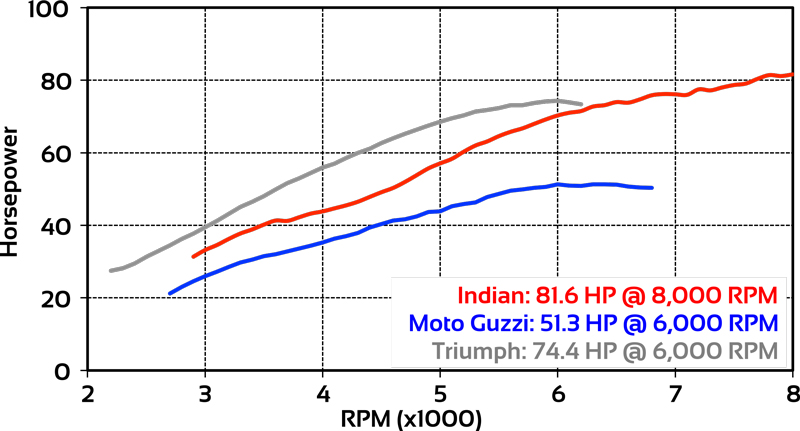
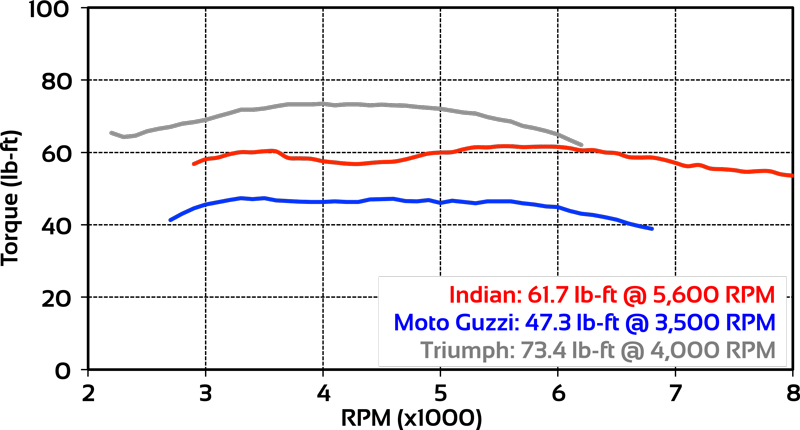
Keep scrolling for full specs on all three models.

2018 Indian Scout Bobber Specs
Base Price: $11,499
Price as Tested: $11,999 (Bronze Smoke paint)
Warranty: 2 yrs., unltd. miles
Website: indianmotorcycle.com
Engine
Type: Liquid-cooled, transverse 60-degree V-twin
Displacement: 1,133cc
Bore x Stroke: 99.0 x 73.6mm
Compression Ratio: 10.7:1
Valve Train: DOHC, 4 valves per cyl.
Valve Insp. Interval: 20,000 miles
Fuel Delivery: Closed-loop EFI w/ 60mm throttle bodies x 2
Lubrication System: Semi-dry sump, 5.0-qt. cap.
Transmission: 6-speed, cable-actuated wet clutch
Final Drive: Belt
Electrical
Ignition: Electronic digital
Charging Output: 497 watts max.
Battery: 12V 12AH
Chassis
Frame: Cast aluminum backbone w/ engine as stressed member & oval-section steel swingarm
Wheelbase: 61.5 in.
Rake/Trail: 29 degrees/4.7 in.
Seat Height: 25.6 in.
Suspension, Front: 41mm cartridge fork, no adj., 4.7-in. travel
Rear: Dual shocks, adj. for spring preload, 2.0-in. travel
Brakes, Front: Single 298mm disc w/ 2-piston floating caliper
Rear: Single 298mm disc w/ 1-piston floating caliper
Wheels, Front: Cast, 3.50 x 16 in.
Rear: Cast, 3.50 x 16 in.
Tires, Front: 130/90-16H
Rear: 150/80-16H
Wet Weight: 542 lbs.
Load Capacity: 446 lbs.
GVWR: 988 lbs.
Performance
Fuel Capacity: 3.3 gals., last 0.5 gal. warning light on
MPG: 91 PON min. (avg) 40.8
Estimated Range: 135 miles
Indicated RPM at 60 MPH: 3,200
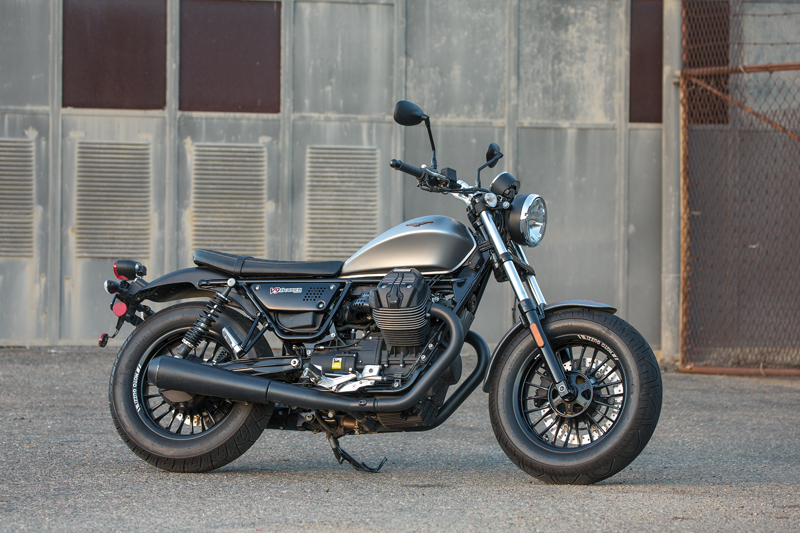
2017 Moto Guzzi V9 Bobber Specs
Base Price: $10,490
Warranty: 2 yrs., unltd. miles
Website: motoguzzi-us.com
Engine
Type: Air-/oil-cooled, longitudinal 90-degree V-twin
Displacement: 853cc
Bore x Stroke: 84.0 x 77.0mm
Compression Ratio: 10.5:1
Valve Train: OHV, 2 valves per cyl.
Valve Insp. Interval: 6,200 miles
Fuel Delivery: EFI w/ 38mm throttle bodies x 2
Lubrication System: Wet sump, 2.1-qt. cap.
Transmission: 6-speed, cable-actuated dry clutch
Final Drive: Shaft
Electrical
Ignition: Electronic
Charging Output: 270 watts max.
Battery: 12V 18AH
Chassis
Frame: Steel twin-tube cradle & cast aluminum swingarm
Wheelbase: 57.7 in.
Rake/Trail: 26.4 degrees/4.6 in.
Seat Height: 30.7 in.
Suspension, Front: 40mm stanchions, no adj., 5.1-in. travel
Rear: Dual shocks, adj. for spring preload, 3.8-in. travel
Brakes, Front: Single 320mm disc w/ 4-piston floating caliper & ABS
Rear: Single 260mm disc w/ 2-piston floating caliper & ABS
Wheels, Front: Cast, 3.50 x 16 in.
Rear: Cast, 4.00 x 16 in.
Tires, Front: 130/90-16
Rear: 150/80-B16
Wet Weight: 472 lbs.
Load Capacity: 454 lbs.
GVWR: 926 lbs.
Performance
Fuel Capacity: 4.0 gals., last 1.0 gal. warning light on
MPG: 90 PON min. (avg) 45.7
Estimated Range: 183 miles
Indicated RPM at 60 MPH: NA
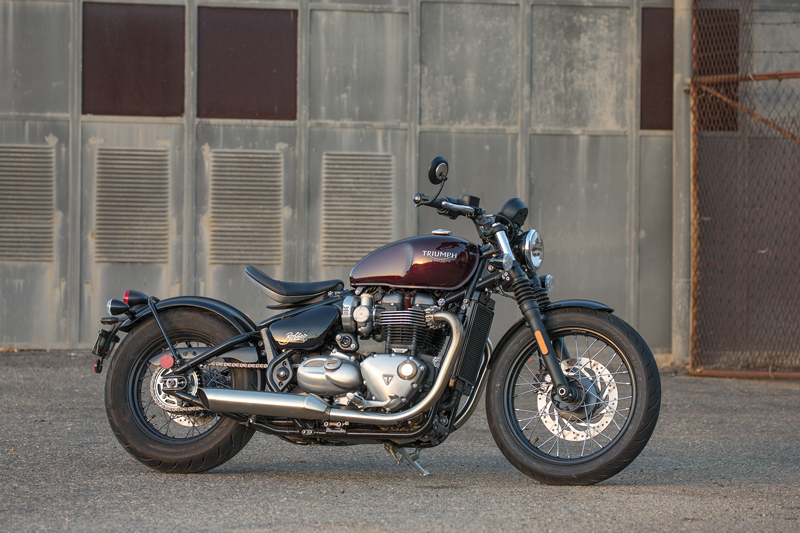
2017 Triumph Bonneville Bobber Specs
Base Price: $11,900 (Jet Black)
Price as Tested: $12,150 (Morello Red)
Warranty: 2 yrs., unltd. miles
Website: triumphmotorcycles.com
Engine
Type: Liquid-cooled, transverse parallel twin
Displacement: 1,200cc
Bore x Stroke: 97.6 x 80.0mm
Compression Ratio: 10.0:1
Valve Train: OHV, 4 valves per cyl.
Valve Insp. Interval: 12,000 miles
Fuel Delivery: Multipoint sequential EFI w/ 44mm throttle bodies x 2
Lubrication System: Wet sump, 4.0-qt. cap.
Transmission: 6-speed, cable-actuated assist wet clutch
Final Drive: Chain
Electrical
Ignition: Electronic
Charging Output: 558 watts max.
Battery: 12V 10AH
Chassis
Frame: Tubular-steel cradle & tubular-steel swingarm
Wheelbase: 59.4 in.
Rake/Trail: 25.8 degrees/3.5 in.
Seat Height: 27.2 in.
Suspension, Front: 41mm stanchions, no adj., 3.5-in. travel
Rear: Single shock, adj. for spring preload, 3.0-in. travel
Brakes, Front: Single 310mm disc w/ 2-piston floating caliper & ABS
Rear: Single 255mm disc w/ 1-piston floating caliper & ABS
Wheels, Front: Spoked, 2.50 x 19 in.
Rear: Spoked, 3.50 x 16 in.
Tires, Front: 100/90-19
Rear: 150/80-R16
Wet Weight: 534 lbs.
Load Capacity: 275 lbs.
GVWR: 809 lbs.
Performance
Fuel Capacity: 2.4 gals., last 0.5 gal. warning light on
MPG: 87 PON min. (avg) 47.5
Estimated Range: 114 miles
Indicated RPM at 60 MPH: 2,500

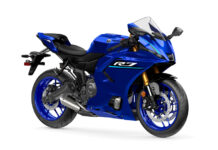

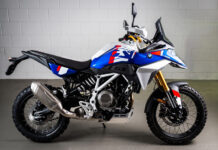
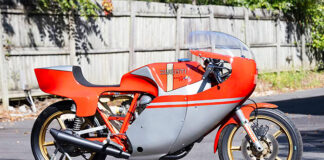
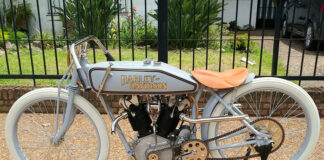
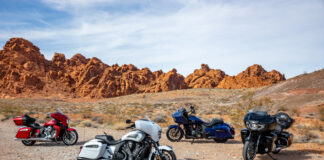

Fuel delivery spec is wrong on the Indian. Only a single throttle body. Not 2.
The moto guzzi valve inspection at 6000 miles would be a turn off to me.
With the heads sticking out like that, checking the valves on the Guzzi is a simple procedure.
Tough call for me between the Indian and the Triumph. I lean towards the Triumph, but just can’t get over that tiny fuel range. Wonder if the new Speedmaster tank would fit on it…
Great Idea !
You said the triumph was ” the distiguished gentleman being the only one to come with standard abs and switchable traction control” but you also mention that the “least expensive guzzi has abs traction control and brembo brakes”.
‘They prize form over function, emotion and feel over pure logic.’
Not the case with Triumphs Bobber. Mid controls, upright seat with room to tuck in. One of the best handling bikes I have ever owned.
Love triumphs and a great looking bike but ide go for the guzzi as i could be a better all round bike and you can tour on it
Triumph load capacity 275lb! WTF?
Ill take the Guzzi please. best looking of the bunch and years upon years of development on that lovely engine.